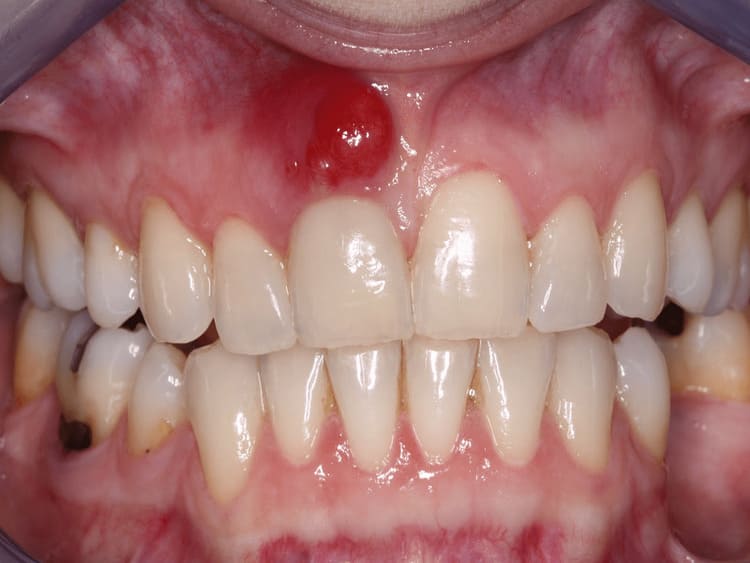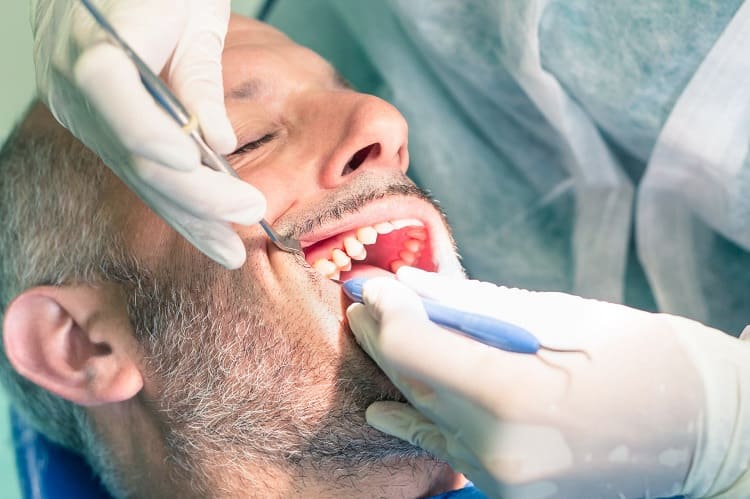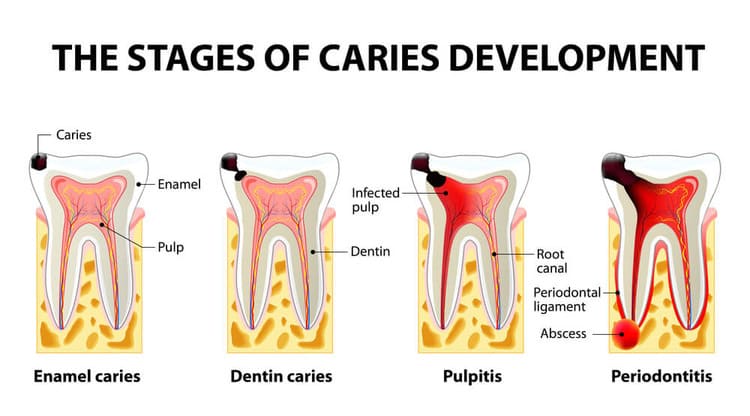Purulent periodontitis – How is it treated?
Purulent periodontitis is a rather dangerous disease and it can cause complications if not treated promptly. Therefore, in this article, let’s learn about the causes, signs and treatment methods of purulent root canal disease with Dr.Muoi.
1. What is purulent gingivitis?
Purulent periodontitis is a condition in which the root of your tooth or the part of your gums encounters a strong attack of bacteria, leading to an infection. In addition, it is caused by too much tartar that spreads below the gums and leads to inflammation of the roots, then forming a pocket of pus. This condition is also known as a tooth abscess and it is a very dangerous phenomenon.
 Purulent root inflammation is also known as tooth abscessPeople who have a tooth abscess often experience a lot of pain with varying degrees of pain. This pain can even spread to the jaw, ear and neck area. If not treated definitively, it will most likely become serious, causing blood infection and life-threatening.
Purulent root inflammation is also known as tooth abscessPeople who have a tooth abscess often experience a lot of pain with varying degrees of pain. This pain can even spread to the jaw, ear and neck area. If not treated definitively, it will most likely become serious, causing blood infection and life-threatening.
2. Types of purulent root inflammation
Purulent root inflammation currently has 3 common forms. Let’s find out together:
Purulent gingivitis currently has 3 common forms
Inflammation around the apex of the tooth
Periodontitis is inflammation that occurs at the tip of the root of a tooth. The main cause of this phenomenon is because bacteria enter the pulp through a small hole in the tip of the tooth, causing inflammation.
Periodontitis
Periodontitis is a form of inflammation that occurs in your gums, ligaments, and alveolar bone. It can also be the result of an injury.
If periodontitis is not treated in time, it will most likely spread to the surrounding tissues and bone of the inflamed tooth root.
Gingivitis
When the gum that surrounds the root of your tooth becomes inflamed, it causes the gums to swell and pus. This is gingivitis. The cause of gingivitis can be due to fish bones, popcorn shells or toothbrush bristles stuck inside… In addition, it can also be due to increased usage habits that cause damage to the gums.
3. Symptoms of purulent periodontitis
Symptoms of a tooth abscess are usually pretty easy to spot. That’s when you feel a sharp pain in the root of the tooth and the gum that surrounds the tooth is inflamed. These pains will often come on suddenly and tend to get worse over time if left untreated.
 Symptoms to recognize tooth root pus are quite easy
Symptoms to recognize tooth root pus are quite easy
There are also some other symptoms such as:
- The pain will be felt throughout the jaw, ear and neck area
- The pain tends to be worse when you lie on your side towards the swollen tooth
- When chewing or biting, it will feel intense pain
- The inflamed side of the tooth will feel swollen
- The part of your gums will be swollen, red and hotter than other places.
- Feeling sensitive and sensitive teeth
- Your teeth will be discolored or loose.
- You will feel bad breath and a fishy taste in your mouth. This phenomenon occurs even when you keep your teeth clean.
- Feel the lymph nodes in the neck or under the jaw become tender and swollen.
- Occurrence of fever
In case the pus mass at the root of your tooth is broken, you will feel the pain is greatly reduced, even relieved. Then the fishy smell and taste of blood will spread in the mouth.
4. Causes of purulent root inflammation
Bacteria that enter the pulp or the gum will cause inflammation of the pus pocket. Some of the factors that contribute to an increased risk of purulent root swelling are:
Poor oral hygiene
The process of taking care of your teeth and if not done properly increases the risk of tooth decay. For example, you don’t brush your teeth twice a day and don’t floss to clean between your teeth.
Diet with too much sugar
If you regularly use foods with a lot of sugar such as sweets or soft drinks, it also increases the phenomenon of tooth decay and can cause pus-root discharge after a long time.
Dry mouth
Dry mouth is also one of the most important oral health problems. The cause of this phenomenon is due to the side effects of certain drugs or due to the aging of the body.

5. Complications of purulent root inflammation
Anyone experiencing pus-filled root swelling needs to be treated promptly. Even if your pus sac ruptures, you still need to see a doctor and clean the area to ensure the safest oral condition, to avoid the infection from spreading.
 Purulent periodontitis without timely treatment can easily cause complications
Purulent periodontitis without timely treatment can easily cause complications
If you experience signs of an inflamed tooth and the following symptoms, you need to see your dentist right away:
- Have a high fever
- The side of the inflammation of the tooth root is swollen
- Difficulty eating and swallowing
- Heart beat is too fast and intense
- The mind is drowsy and often confused
These are warning signs that your root canal is seriously infected. Therefore, it is necessary to take measures to correct the problem immediately.
In the absence of treatment, the purulent root of the tooth can spread to the jawbone, the head and even the brain. In particular, in some cases, it can lead to blood infections and be life-threatening.
6. How to treat purulent periodontitis?
To cure purulent root canal inflammation, dentists first need to clean the infected site and provide a pain relief plan. Depending on your symptoms, you may be offered an X-ray to pinpoint the site and evaluate for an infection.
Gargle with salt water
Rinsing your mouth with salt water is an extremely necessary thing even if you do not have pus-filled root swelling. Gargling with salt water will help remove bacteria as well as clean your oral cavity. This is an extremely effective home remedy for purulent root canal inflammation.

Dr.Muối It is one of the products that is being appreciated by many people. The product contains many minerals that are extremely good for teeth such as Ca, K, Mg…
Drainage of pus mass
With the method of mass drainage, the doctor will make a small cut on the inflamed tooth root to drain the pus mass. They will then proceed to clean the inflamed area to prevent the infection from spreading to the surrounding area.
Take tooth pulp

The pulp is the inner soft part of the tooth. It has nerves, connective tissue, and blood vessels. Dentists need to conduct a root canal to save teeth that are decayed or teeth with inflamed roots by drilling a small hole in the tooth and then removing the nerve and pulp. The inside of the tooth that takes the pulp will be cleaned before filling or crowning the porcelain tooth.
Tooth extraction
The way to cure purulent gingivitis in case the infection is too severe is to extract the tooth first and then proceed to clean the inflammation.
Due to antibiotic use
If the inflammation in the root of the tooth has spread around or your body’s immune system is not strong enough to fight the infection, then your doctor will prescribe antibiotics for you.
Minor surgery to remove foreign body
There are some cases where the phenomenon of inflammation of the root of the tooth is caused by a foreign body. At this point, surgery is required to remove those foreign bodies. Next, it is necessary to proceed to clean the inflamed area.
Recently, Dr.Mui shared about purulent root inflammation for your reference. Do not forget to use mouthwash daily to improve the condition of the gums as well as limit the diseases related to the teeth. Refer to Dr.Muoi mouthwash immediately here
You Can Refer To More Articles:
Should I wash my nose with physiological saline?
Instructions for Self-healing Sinusitis with Physiological Salt Water
Tips for Treating Allergic Rhinitis with Physiological Salt Water Simple and Effective
Instructions on how to hydrate with salt water to treat bad breath

